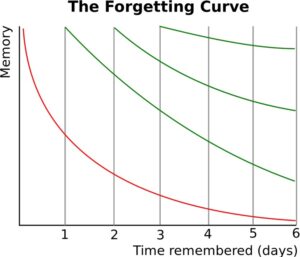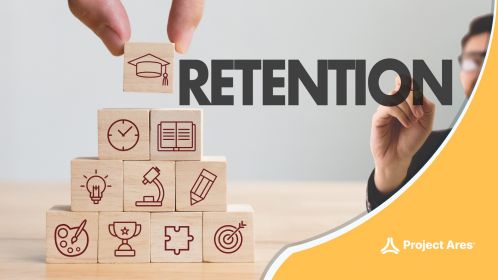Forgetting what was taught at the beginning of class, two weeks ago, or even yesterday is a common challenge educators experience in their classrooms. It’s also a frustrating experience for students when their success requires remembering material mentioned once or outside of its useful context.

Struggles with Knowledge Retention
Wouldn’t it be a lot easier if students memorized every aspect of our lectures? Absolutely! Unfortunately, that’s an unlikely scenario.
Why? People are wired to forget things. Why? Hermann Ebbinghaus , a 19th-century psychologist, has that answer. Ebbinghaus conducted memory experiments that revealed an exponential forgetting curve . He proved that his subjects forgot nearly two-thirds of the information he exposed them to 24 hours earlier. After a couple of days without a review, his subjects remembered only one-fifth of the material.

For biological reasons, it’s important to forget. However, it’s not desirable when we, as educators, need our students to retain knowledge. Today, many instructors
- Hand out all of the material on one topic at once.
- Assess their knowledge of the information.
- Move on to the next topic.
Common student responses to this curriculum style are cramming for tests. While this is effective for a short time, it doesn’t foster long-term retention. Neither does our strategy of mass repetition when we’re delivering our course material.
There are many approaches to optimizing linear efficiency and knowledge retention. For example, EdTech products, like Project Ares, use a whole collection of them. However, rushing to adopt modern technologies without understanding the pedological concepts behind them will set you and your students up for disappointment.
Teaching Cybersecurity Using Spaced Repetition
Going back to Ebbinghaus’ study, there is one approach for achieving knowledge retention. It’s called Spaced Repetition , and it has a great deal of supporting evidence. This teaching technique involves supplementing initial exposure to learning material and then re-exposing it over longer time scales. It empowers our brains to retain knowledge and demonstratively improves the learning experience.
The spacing effect is one of the most well-proven phenomena in memory studies and a fundamental capability that we should take advantage of to become better educators. Traditionally, the ideology around this effect applied only to memorization tasks. Modern studies now show that this approach is also beneficial for learning principles. To implement it, spread out material over time and occasionally revisit old content to maximize learner retention. Now, this may seem counterintuitive. Many curriculums have students try to fully master one topic before moving on to the next or deliver the material close to testing time. To maximize long-term knowledge retention for our students, we need to apply spaced repetition into our teaching.
If you’re teaching cybersecurity or any other subject, there’s a role for spaced repetition in your
- Lectures
- Homework assignments
- Hands-on engagement
- Test-driven exposures
Building spaced retention methods into your syllabi will help students retain knowledge longer.
Five Spaced Repetition Tips
Below are five helpful tips to help you introduce spaced repetition in your lessons.
1. Include Intermittent Recaps of Past Concepts
Connect assorted topics to create student-teacher dialogue and give students a direct opportunity to recall that information.
2. Build Engaging Spaced Repetition Exercises into Your Homework Assignments
Include slight variations of earlier exercises into later assignments or add them in as extra credit. Don’t make them time-consuming or difficult.
3. Consider Simpler Problems
Basic questions will put your students in a position to recall earlier concepts.
4. Use Hands-on Engagement
Reading articles, papers, or blog posts to refresh our knowledge on a topic is not enough. Actively engage your students to re-learn, recall, and refresh previous information. For example, add steps in your lab that reintroduce a tool used in an earlier semester.
5. Offer Feedback on Test-driven Exposures
Point out where students struggled on an exam or in the lab. Students like to see this type of feedback as it offers opportunities for additional dialogue and knowledge retention.
Explicitly tell students that the learning material is focused on lifelong habits to improve knowledge retention when the material is delivered. That step is quite important.
Now there’s no definitive evidence that suggests a best spaced-repetition strategy, but the empirical evidence is clear that the overall process of having multiple exposures over time is effective. How long do you want your students to retain a particular fact, a piece of information, or a principle? The desired length of retention will inform the recommended spacing intervals from a functional and practical perspective.
Based on Ebbinghaus’ research, if you want your students to retain classroom material for:
- A week, then consider spaced repetition one to two days from initial exposure.
- A month, then consider repetition intervals of one to two weeks from initial exposure.
The goal is to have students retain your teachings beyond the end of the three to four-month semester timeframe. Therefore, your curriculum should revisit material every three to four weeks to encourage re-engagement and retention.
How to Use Project-Based Learning in Teaching
There’s no substitute for a hands-on, project-based experience when teaching cybersecurity. EdTech products like Project Ares allow students to work through labs with available hints to guide them. Here, students can revisit and reengage with labs that they’ve completed previously to get a hands-on refresher.
Instructors can also engage in their students’ learning by disabling the hints and use the labs to perform assessments. Just make sure to offer your students hands-on practice before performing them. Upon completion, Project Ares will show you an accurate, granular valuation of where your students are in terms of their skills and how much course material they’re retaining.
Develop Life-long Learning Habits
It’s a naïve expectation that all students will engage in these spaced repetition exercises or recall the material voluntarily. We, as educators, can encourage them to develop lifelong learning habits that focus on knowledge retention through our spaced repetition strategies.
To get the full scoop on the Project Ares pedagogy series, watch Dr. Brad Hayes, Chief Technology Officer at Project Ares, in-depth talk on Spaced Repetition !





